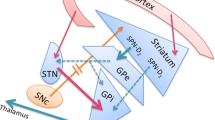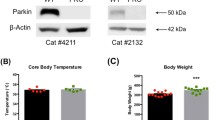Abstract
In idiopathic Parkinson’s disease, clinical symptoms do not emerge until consistent neurodegeneration has occurred. The late appearance of symptoms implies the existence of a relatively long preclinical period during which several disease-induced neurochemical changes take place to mask the existence of the disease and delay its clinical manifestations. The aim of this study was to examine the neurochemical, neurophysiological, and behavioral changes induced by the loss of nigrostriatal innervation in the En1+/−;En2−/− mouse, in the 10 months following degeneration, compared to En2 null mutant mice. Behavioral analysis (Pole-test, Beam-walking test, and Inverted grid test) and field potential recordings in the striatum indicated that loss of ~70% of nigrostriatal neurons produced no significant functional effects until 8 months of age, when En1+/−;En2−/− animals started to show frank motor deficits and electrophysiological alterations in corticostriatal plasticity. Similarly, alterations in dopamine homeostasis, dopamine turnover, and dopamine innervation were observed in aged animals compared to young En1+/−;En2−/− mice. These data suggests that in En1+/−;En2−/− mice nigrostriatal degeneration in the substantia nigra is functionally compensated.





Similar content being viewed by others
References
Adams JR, van Netten H, Schulzer M et al (2005) PET in LRRK2 mutations: comparison to sporadic Parkinson’s disease and evidence for presymptomatic compensation. Brain 128:2777–2785
Albéri L, Sgadò P, Simon HH (2004) Engrailed genes are cell-autonomously required to prevent apoptosis in mesencephalic dopaminergic neurons. Development 131:3229–3236
Bergstrom BP, Schertz KE, Weirick T et al (2001) Partial, graded losses of dopamine terminals in the rat caudate-putamen: an animal model for the study of compensatory adaptation in preclinical parkinsonism. J Neurosci Methods 106:15–28
Bernheimer H, Birkmayer W, Hornykiewicz O et al (1973) Brain dopamine and the syndromes of Parkinson and Huntington. Clinical, morphological and neurochemical correlations. J Neurol Sci 20:415–455
Bezard E, Jaber M, Gonon F et al (2000) Adaptive changes in the nigrostriatal pathway in response to increased 1-methyl-4-phenyl-1,2,3,6-tetrahydropyridine-induced neurodegeneration in the mouse. Eur J Neurosci 12:2892–2900
Bezard E, Dovero S, Prunier C et al (2001) Relationship between the appearance of symptoms and the level of nigrostriatal degeneration in a progressive 1-methyl-4-phenyl-1,2,3,6-tetrahydropyridine-lesioned macaque model of Parkinson’s disease. J Neurosci 21:6853–6861
Calabresi P, Saiardi A, Pisani A et al (1997) Abnormal synaptic plasticity in the striatum of mice lacking dopamine D2 receptors. J Neurosci 17:4536–4544
Calne DB, Langston JW, Martin WR et al (1985) Positron emission tomography after MPTP: observations relating to the cause of Parkinson’s disease. Nature 317:246–248
Cannon JR, Tapias V, Na HM et al (2009) A highly reproducible rotenone model of Parkinson’s disease. Neurobiol Dis 34:279–290
Corsini GU, Maggio R, Vaglini F (2002) Molecular and cellular events regulating dopamine neuron survival. In: di Chiara GD (ed) Handbook of experimental pharmacology. Dopamine in the CNS II, vol 154. Springer-Verlag, Berlin Heidelberg, pp 321–386
de la Fuente-Fernández R (2007) Presynaptic mechanisms of motor complications in Parkinson disease. Arch Neurol 64:141–143
Fleming SM, Zhu C, Fernagut PO et al (2004) Behavioral and immunohistochemical effects of chronic intravenous and subcutaneous infusions of varying doses of rotenone. Exp Neurol 187:418–429
Fournier M, Vitte J, Garrigue J et al (2009) Parkin deficiency delays motor decline and disease manifestation in a mouse model of synucleinopathy. PLoS One 4(8):e6629
George S, Mok SS, Nurjono M et al (2010) α-Synuclein transgenic mice reveal compensatory increases in Parkinson’s disease-associated proteins DJ-1 and Parkin and have enhanced α-Synuclein and PINK1 levels after rotenone treatment. Mol Neurosci 42:243–254
Geracitano R, Paolucci E, Prisco S et al (2003) Altered long-term corticostriatal synaptic plasticity in transgenic mice overexpressing human CU/ZN superoxide dismutase (GLY(93) → ALA) mutation. Neuroscience 118:399–408
Gerlai R, Millen KJ, Herrup K et al (1996) Impaired motor learning performance in cerebellar En-2 mutant mice. Behav Neurosci 110:126–133
Hernandez DG, Paisán-Ruíz C, McInerney-Leo A et al (2005) Clinical and positron emission tomography of Parkinson’s disease caused by LRRK2. Ann Neurol 57:453–456
Hornykiewicz O (1972) Dopamine and extrapyramidal motor function and dysfunction. Res Publ Assoc Res Nerv Ment Dis 50:390–415
Hornykiewicz O (1975) Parkinson’s disease and its chemotherapy. Biochem Pharmacol 24:1061–1065
Joyner AL, Herrup K, Auerbach BA et al (1991) Subtle cerebellar phenotype in mice homozygous for a targeted deletion of the En-2 homeobox. Science 251:1239–1243
Kang MJ, Gil SJ, Koh HC (2009) Paraquat induces alternation of the dopamine catabolic pathways and glutathione levels in the substantia nigra of mice. Toxicol Lett 188:148–152
Kopin IJ (1992) Mechanisms of 1-methyl-4-phenyl-1,2,3,6-tetrahydropyridine induced destruction of dopaminergic neurons. In: Herken H, Hucho F (eds) Handbook of experimental pharmacology, vol 102. Selective neurotoxicity. Springer-Verlag, Berlin, Heidelberg
Matsuura K, Kabuto H, Makino H et al (1997) Pole test is a useful method for evaluating the mouse movement disorder caused by striatal dopamine depletion. J Neurosci Methods 73:45–48
McGeer PL, Itagaki S, Akiyama H et al (1988) Rate of cell death in parkinsonism indicates active neuropathological process. Ann Neurol 24:574–576
Meredith GE, Kang UJ (2006) Behavioral models of Parkinson’s disease in rodents: a new look at an old problem. Mov Disord 21:1595–1606
Meredith GE, Totterdell S, Potashkin JA et al (2008) Modeling PD pathogenesis in mice: advantages of a chronic MPTP protocol. Parkinsonism Relat Disord 14(Suppl 2):S112–S115
Moore RY, Zigmond MJ (1994) Compensatory mechanisms in central neurodegenerative disease. In: Calne DB (ed) Neurodegenerative diseases. W.B. Saunders Company, Philadelphia
Piccini P, Burn DJ, Ceravolo R et al (1999) The role of inheritance in sporadic Parkinson’s disease/evidence from a longitudinal study of dopaminergic function in twins. Ann Neurol 45:577–582
Pifl C, Hornykiewicz O (2006) Dopamine turnover is upregulated in the caudate/putamen of asymptomatic MPTP-treated rhesus monkeys. Neurochem Int 49:519–524
Saueressig H, Burrill J, Goulding M (1999) Engrailed-1 and netrin-1 regulate axon pathfinding by association interneurons that project to motor neurons. Development 126:4201–4212
Sgadò P, Albéri L, Gherbassi D et al (2006) Slow progressive degeneration of nigral dopaminergic neurons in postnatal Engrailed mutant mice. Proc Natl Acad Sci USA 103:15242–15247
Simon HH, Saueressig H, Wurst W et al (2001) Fate of midbrain dopaminergic neurons controlled by the engrailed genes. J Neurosci 21:3126–3134
Sonnier L, Le Pen G, Hartmann A et al (2007) Progressive loss of dopaminergic neurons in the ventral midbrain of adult mice heterozygote for Engrailed1. J Neurosci 27:1063–1071
Sossi V, de la Fuente-Fernández R, Schulzer M et al (2007) Dopamine transporter relation to dopamine turnover in Parkinson’s disease: a positron emission tomography study. Ann Neurol 62:468–474
Sossi V, Dinelle K, Topping GJ et al (2009) Dopamine transporter relation to levodopa-derived synaptic dopamine in a rat model of Parkinson’s: an in vivo imaging study. J Neurochem 109:85–92
Tillerson JL, Caudle WM, Reveron ME et al (2002) Detection of behavioral impairments correlated to neurochemical deficits in mice treated with moderate doses of 1-methyl-4-phenyl-1,2,3,6-tetrahydropyridine. Exp Neurol 178:80–90
Viaggi C, Vaglini F, Pardini C et al (2007) CYP 2E1 mutant mice are resistant to DDC-induced enhancement of MPTP toxicity. J Neural Transm 72(Suppl):159–163
Zigmond MJ, Acheson AL, Stachowiak MK, Stricker EM (1984) Neurochemical compensation after nigrostriatal bundle injury in an animal model of preclinical parkinsonism. Arch Neurol 41:856–861
Zigmond MJ, Abercrombie ED, Berger TW et al (1990) Compensations after lesions of central dopaminergic neurons: some clinical and basic implications. Trends Neurosci 13:290–296
Zigmond MJ, Abercrombie ED, Berger TW et al (1993) Compensatory responses to partial loss of dopaminergic neurons: studies with 6-hydroxydopamine. In: Schneider JS, Gupta M (eds) Current concepts in Parkinson’s disease research. Hans Huber Pub, Berne, Switzerland, pp 99–140
Acknowledgments
We thank Martyn Goulding (Salk Institute, La Jolla, CA) and Alex Joyner (Memorial Sloan-Kettering Cancer Center, New York, NY) for initially providing the En1-tauLacZ and the En2 mutant mice. We thank Yuri Bozzi for helpful comments on the manuscript and Tommaso Schiavinotto for help with the statistical analysis. The authors would like also to thank Mrs Ornella Baroni for her precious help in animal care. This work was supported by PRIN grants “prot nr. 2005055445, anno 2005”.
Author information
Authors and Affiliations
Corresponding author
Rights and permissions
About this article
Cite this article
Sgadò, P., Viaggi, C., Pinna, A. et al. Behavioral, Neurochemical, and Electrophysiological Changes in an Early Spontaneous Mouse Model of Nigrostriatal Degeneration. Neurotox Res 20, 170–181 (2011). https://doi.org/10.1007/s12640-010-9232-9
Received:
Revised:
Accepted:
Published:
Issue Date:
DOI: https://doi.org/10.1007/s12640-010-9232-9




